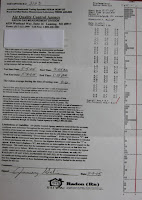One of the most inexpensive, yet invaluable air pollution safety tests you can perform at your home or office is the radon test. Radon gas, another of the 'silent killers', is a form of radiation poisoning that causes respiratory distress and eventually lung cancer. Assessing radon risk is tricky as it is an invisible, odorless, radioactive gas that seeps from the ground to the air above. Higher outdoor pressure forces leaks through cracked and porous cement foundations and walls. Today's modern airtight homes, combined with leaky foundations, can have much higher levels of radon than what is deemed to be safe. No level is completely safe other than zero, but that is very unrealistic. All buildings have some level of radon however minute.
The best time of year to test for radon is during the winter heating months when the house is sealed up. Test kits range from simplistic envelopes or canisters to sophisticated machines. Simple test kits involve the use of a small envelope or canister placed in an area of the home most likely to be emitting the most radon. In a basement it would be placed in an area free from drafts, high heat or humidity, and away from exterior walls. If you have no basement it will be placed on the main floor or in a crawlspace. The envelope or canister is left for a few days undisturbed to collect any radon particles in the air. It is then sealed up and returned for test results.
These inexpensive radon test kits can be purchased at hardware or home supply stores from five to twenty-five dollars. Just be sure the cost includes laboratory analysis. Some local health departments supply the kits at a reduced cost or even free. So check with them first. For more rigid testing, you can hire a company that will come to your home or office and set up a continuous radon monitoring machine that tests the ambient air for radon gas every few minutes and prints out a continuous reading of those measurements. It is much more accurate because radon levels are constantly fluctuating. Normal spikes in the readings can be overlooked if they are infrequent enough over the course of several hours or days. When considering a property investment this form of testing is more desirable because it is tamperproof. Any movement of the machine is detected and recorded, preventing the property owner from placing the machine in another location in an attempt to skew the results. Below is a sample of a printout from one of these machines. Click on it for a closeup view.
Test results at 4pCi/L or less are considered to be safe levels by the U. S. Environmental Protection Agency. So your first results come back at well under the recommended safety level of 4pCi/L. You're done for now and can get some sleep. You may want to test again in six months or one year just to be sure. After that every three to five years should suffice. It is also recommended to retest after major renovations and when replacing heating systems or central air conditioning.
Levels from 4-10pCi/L warrant further long-term testing. If your results came back in this range, you need to run a long-term test for accuracy before considering having a mitigation system installed as they can be quite costly.
Anything over 10pCi/L is significantly high and should be addressed as soon as possible to prevent further health issues. An additional short-term test can be performed to verify results. During this testing period you should be contacting radon specialists to get several different estimates on mitigation systems.
The primary method used to reduce radon is a vent pipe system. The pipe pulls radon gas from beneath the building and vents it outside through a wall away from doors or windows or through an attic with a fan where the gas is then diluted into the air. In crawlspaces a heavyweight plastic is used to cover the ground or concrete floor and gas is vented from beneath the plastic. Porous concrete walls and floors of basements are sometimes sealed but this method is not always reliable due to varying results. You can find more information on mitigation systems as well as free radon pamphlets at this EPA website.
These inexpensive radon test kits can be purchased at hardware or home supply stores from five to twenty-five dollars. Just be sure the cost includes laboratory analysis. Some local health departments supply the kits at a reduced cost or even free. So check with them first. For more rigid testing, you can hire a company that will come to your home or office and set up a continuous radon monitoring machine that tests the ambient air for radon gas every few minutes and prints out a continuous reading of those measurements. It is much more accurate because radon levels are constantly fluctuating. Normal spikes in the readings can be overlooked if they are infrequent enough over the course of several hours or days. When considering a property investment this form of testing is more desirable because it is tamperproof. Any movement of the machine is detected and recorded, preventing the property owner from placing the machine in another location in an attempt to skew the results. Below is a sample of a printout from one of these machines. Click on it for a closeup view.
Test results at 4pCi/L or less are considered to be safe levels by the U. S. Environmental Protection Agency. So your first results come back at well under the recommended safety level of 4pCi/L. You're done for now and can get some sleep. You may want to test again in six months or one year just to be sure. After that every three to five years should suffice. It is also recommended to retest after major renovations and when replacing heating systems or central air conditioning.
Levels from 4-10pCi/L warrant further long-term testing. If your results came back in this range, you need to run a long-term test for accuracy before considering having a mitigation system installed as they can be quite costly.
The primary method used to reduce radon is a vent pipe system. The pipe pulls radon gas from beneath the building and vents it outside through a wall away from doors or windows or through an attic with a fan where the gas is then diluted into the air. In crawlspaces a heavyweight plastic is used to cover the ground or concrete floor and gas is vented from beneath the plastic. Porous concrete walls and floors of basements are sometimes sealed but this method is not always reliable due to varying results. You can find more information on mitigation systems as well as free radon pamphlets at this EPA website.
HAPPY BREATHING!!!



No comments:
Post a Comment
Please feel free to ask any questions you might have, or share other tips and tricks for combating allergies, asthma, and toxins in our environment with other readers.